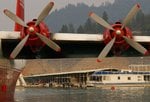I had a high school teacher that flew in AD4s as a radar operator. He told me there was barely enough room in the radar compartment for one person.
The ones sold the Brit Fleet Air-arm and RAF were like that. You can see one or two preserved examples - with hatch - at Duxford IWM Museum.
BTW have you ever seen the Coal Hole in the Sea-Vixen or the PR Canberra ?
Its amazing - you are 30,000 feet up but you never see the light and you can hardly swing a cat, or more at all !


